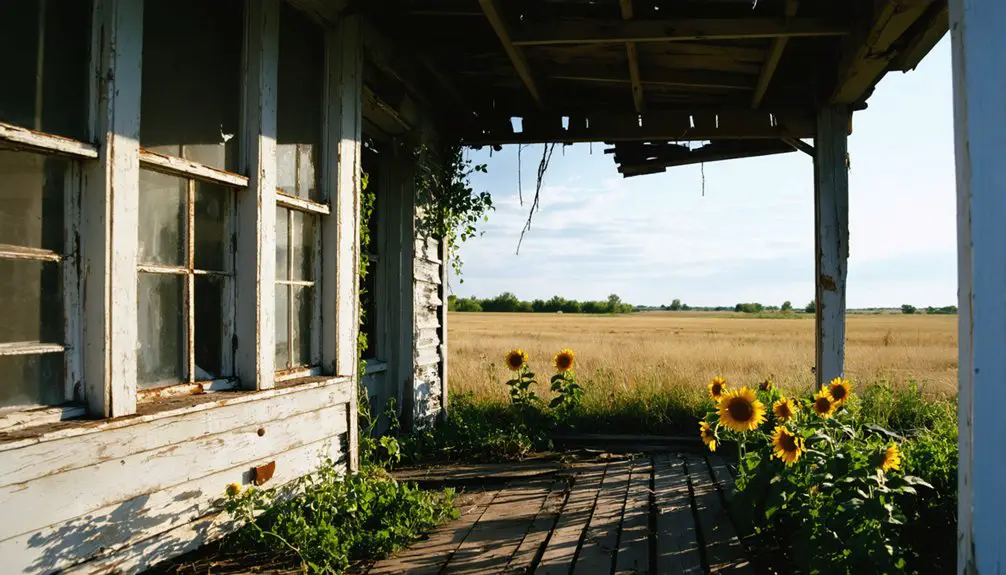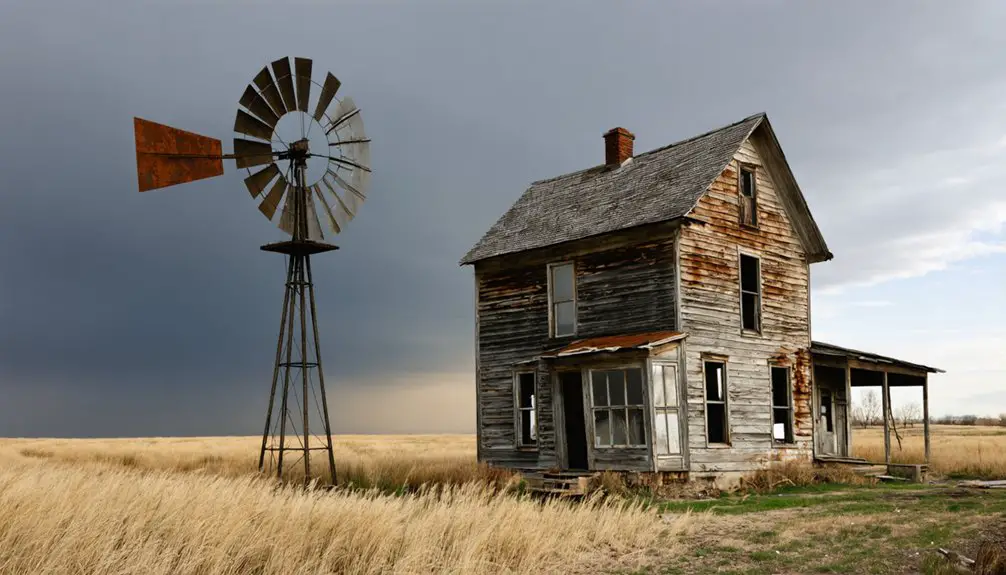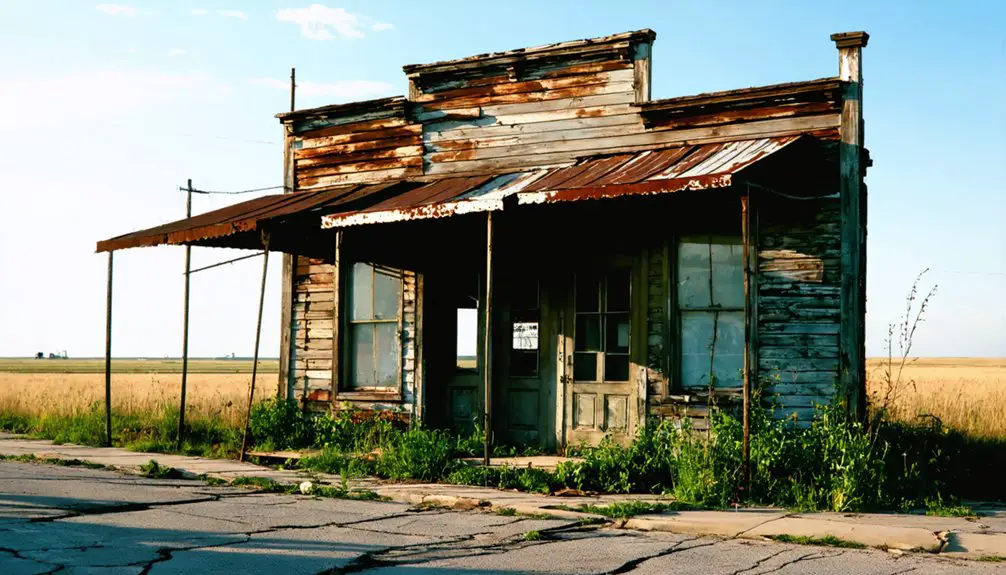You’ll find Spring Ranche’s ghost town remnants 2 miles south of Glenvil, Nebraska along the Little Blue River. Established in 1863 as a Pony Express station and Oregon Trail stop, this frontier settlement once bustled with 100 residents, a sawmill, and various businesses. Though raids and relocations shaped its destiny, you can still explore two original houses, the old cemetery with 151 memorials, and a bridge steeped in paranormal lore. The echoes of frontier life await your discovery.
Key Takeaways
- Spring Ranche was established in 1863 as a Pony Express station and trading post on Nebraska’s Little Blue River.
- The town reached its peak population of 100 residents in 1871, featuring businesses, a sawmill, and post office.
- Following Lakota raids in 1864 and relocation in 1886 for railroad access, the town gradually declined into abandonment.
- Today, only two original houses remain, with scattered foundations and a cemetery containing 151 memorials marking the ghost town’s location.
- The site is located 2 miles south of Glenvil, Nebraska, with GPS coordinates 40.437409, -98.24033, accessible via rural roads.
Origins Along the Little Blue River

As pioneers pushed westward along the Oregon-California Trail, Spring Ranche emerged as an essential outpost in 1863 when James Bainter established a store and inn on the north bank of the Little Blue River. This strategic location showcased pioneer resilience, serving as both a Pony Express relay station and a vital supply point for travelers heading west. Letters could be transported from Atchison to Sacramento in just eight days through this critical route. You’ll find the original settlement took full advantage of river resources, positioning itself where access to water, timber, and transportation routes intersected. The town experienced significant growth and reached a peak population of about 100 residents during its most prosperous period.
Life at the Oregon-California Trail Stop
While emigrants faced grueling conditions along the Oregon-California Trail, Spring Ranche offered essential respite and resources for weary travelers.
You’d find yourself rising early with other emigrants, walking alongside ox-drawn wagons through Nebraska’s tall prairie grass while battling fierce winds and storms. The journey was part of the 2,170-mile route that connected Missouri River to Oregon Territory. Each day, travelers would need to meet the fifteen mile quota to stay on schedule.
At the stop, you’d manage scarce resources carefully. With limited firewood available, you’d gather buffalo chips to fuel your cooking fires. The Little Blue River provided crucial water for both people and livestock.
Settlers gathered precious buffalo chips to kindle their fires, while the Little Blue River quenched their thirst along the trail.
You’d join other travelers in hunting nearby bison to replenish meat supplies and make jerky. The station keepers helped maintain order and safety, though dangers from Native American attacks remained real – as evidenced by the ranch’s burning in 1864.
Despite these challenges, Spring Ranche’s location made it an invaluable rest stop.
The Devastating 1864 Lakota Sioux Attacks
During the hot summer of 1864, Lakota Sioux warriors launched a devastating series of coordinated attacks across Nebraska’s Overland Trail routes, striking ranches, stations, and wagon trains along a 250-mile stretch from Julesburg to Kiowa Station.
The raids, planned from a large camp on the Solomon River, demonstrated sophisticated Lakota resistance against westward expansion. The tension between tribes intensified after this period, culminating in the death of Sky Chief, a prominent Pawnee leader, during the Battle at Massacre Canyon. The Dog Soldiers faction continued their fierce resistance against U.S. expansion through ongoing raids in the region.
You’ll find that war parties, led by chiefs Spotted Tail and Pawnee Killer, cleverly disguised themselves as friendly Otoes and Pawnees before striking on Sunday, August 7. This strategy caught many settlers off guard, resulting in over fifty casualties and severely disrupting travel and commerce along the essential trail system.
The attacks heightened settler tensions throughout the region and marked a turning point in the broader Colorado War, as the Lakota fought to protect their ancestral lands.
Rebuilding and Growth Years (1870-1886)
Following the devastating Lakota raids of 1864, Spring Ranch rose from the ashes in 1870 when determined settlers established a new post office south of the Little Blue River. Under the leadership of Lewis Thayer, the first postmaster, the community began to take shape. The community’s resilience shone through as they rebuilt, with a sawmill opening in 1871 to support local construction. The settlement was also designated as Pony Express stop #9 along the route.
You’d have found a bustling settlement that served as both a stagecoach and Pony Express stop, showcasing remarkable economic revival.
Key developments during this period included:
- Growth to approximately 100 residents with stores, inns, and various businesses
- Establishment as a vital hub along the Oregon and Overland trails
- Relocation across the Little Blue River in 1886 to capitalize on the new railroad’s arrival
Despite this progress, a dark chapter emerged in 1885 when two residents were lynched by a mob, reflecting the era’s frontier justice.
Railroad Era and Town Relocation
As the St. Joseph and Grand Island Railroad approached in 1886, you’d have witnessed a dramatic transformation of Spring Ranche. The town picked up its roots and moved two miles north across the Little Blue River to embrace the railroad’s economic promise. This strategic relocation marked Spring Ranche’s evolution from a pioneer trail stop to a rail-connected hub.
The railroad impact revolutionized local commerce, bringing a sawmill and new businesses while connecting the community to broader markets. You’d have seen the town’s population swell to nearly 100 residents as economic transformation took hold. Before this growth, the original settlement endured devastating Indian raids that destroyed much of the town.
Buildings and homes sprouted up around the tracks, creating a new town center that replaced the old trail-based settlement. Though Spring Ranche’s prosperity wouldn’t last forever, the railroad era represented its most vibrant period.
The Dark Tale of Taylor and Jones
One of Spring Ranche’s darkest chapters unfolded in 1885 when Elizabeth Taylor and her brother Tom Jones met their end at the hands of an angry mob.
You’ll find their story rooted in bitter land disputes, accusations of murder, and escalating tensions that ultimately led to their lynching from a bridge over the Little Blue River.
Their deaths near what’s now known as the “Haunted Bridge” stand as a stark reminder of frontier justice and vigilantism in Nebraska’s territorial days. The tragedy began when men were found cutting nearby trees, leading to a deadly confrontation that would seal the siblings’ fate.
Vigilante Justice Strikes Spring
During the early hours of a Sunday morning in 1885, a mob of 200 citizens carried out one of Nebraska’s most notorious acts of vigilante justice at Spring Ranch.
The victims, Elizabeth Taylor and her brother Tom Jones, had defied orders to leave the county after Taylor’s sons were jailed for murdering a neighbor. Frontier justice prevailed as the mob, driven by vigilante motivations, surrounded Jones’s house and seized the pair without resistance.
Key factors that led to this dark episode:
- A bitter feud over fences and livestock between Taylor’s family and neighbors
- Suspicions that Taylor had poisoned her husband
- The refusal of Taylor and Jones to heed warnings to leave Clay County
The mob hanged both victims from a bridge over the Little Blue River, marking a grim chapter in Spring Ranch’s history.
Lynching Near Little Blue
In the shadowy hours before dawn in 1885, a vigilante mob of 200 citizens descended upon Thomas Jones’s house near Spring Ranch, Nebraska, determined to carry out their own brand of frontier justice.
The lynching motivations stemmed from accusations that Elizabeth Taylor and her brother Thomas Jones had encouraged Taylor’s sons to murder Robert Roberts, a local homesteader. They’d also been accused of barn burning, sparking intense local hostility.
Despite warnings to leave Clay County, they stayed. The community response was swift and merciless. The mob surrounded the barricaded house where seven people, including a young child, had taken shelter.
When Taylor and Jones refused to come out, the vigilantes seized them by force. Before sunrise, both were hanged from a bridge at Spring Ranch, bypassing any legal proceedings.
Haunted Bridge Legends and Local Lore
Since the tragic lynching of Tom Jones and Elizabeth Taylor in 1885, the bridge over the Little Blue River near Spring Ranch has become Nebraska’s most notorious haunted landmark.
Paranormal investigations regularly document unexplained phenomena, particularly around March 15th, the anniversary of their deaths. You’ll find locals and visitors sharing ghost stories about eerie experiences at this historic site, where witnesses report hearing desperate pleas for mercy and rhythmic creaking sounds reminiscent of swinging bodies.
Three commonly reported paranormal experiences at the bridge:
- Disembodied screams and voices begging for mercy
- Mysterious creaking sounds beneath visitors’ feet
- Unexplained audio and video recordings captured by investigators
The bridge remains publicly accessible, drawing curious visitors who seek to experience these haunting echoes of frontier justice gone wrong.
What Remains Today: Cemetery and Ruins
Beyond the haunted bridge, Spring Ranch’s physical remnants tell a compelling story of frontier life and inevitable change.
You’ll find just two original houses standing near the old mill site, while the school and store have been transformed into farm homes. The cemetery, with its 151 documented memorials, stands as the most complete evidence of the town’s peak era.
As you explore the grounds, you’ll discover the town’s historic significance along the Little Blue River, where natural springs once sustained the community.
While ghost stories still circulate about the cemetery preservation efforts, the peaceful setting betrays little of its supernatural reputation. A historical marker commemorates the site’s importance on the Oregon Trail, though most structures have succumbed to time, leaving only scattered foundations to mark this once-thriving frontier community.
Finding Spring Ranche: Visitor Information
Located roughly 2 miles south of Glenvil, Nebraska, Spring Ranche’s historic site beckons visitors to explore its storied past along the Little Blue River.
You’ll find the site near Road 307, with GPS coordinates 40.437409, -98.24033 marking this remote frontier settlement’s location. Access routes remain largely unchanged since the 1800s, following rural county roads through Nebraska’s heartland.
For a successful visit to Spring Ranche, remember:
- Navigate using GPS coordinates and historical markers, as minimal modern signage exists.
- Pack essential supplies including water, maps, and first aid equipment – there’s no visitor infrastructure.
- Plan your trip according to weather conditions, as the site’s exposed location offers little shelter.
The nearest services are in Glenvil, so prepare for a self-guided adventure into Nebraska’s pioneer history.
Legacy of a Frontier Settlement
While Spring Ranche’s physical remnants have faded into Nebraska’s prairie landscape, its dramatic story exemplifies the turbulent settlement of the American frontier. The settler stories reflect both resilience and struggle – from James Bainter’s pioneering spirit in 1863 to the community’s repeated displacement during Native American conflicts.
You’ll find echoes of frontier challenges in every aspect of Spring Ranche’s history: the dangerous years of the mid-1860s when settlers fled multiple times, the controversial lynching of 1885, and the village’s strategic relocation to meet the railroad in 1886.
What began as a humble store and inn along the Oregon-California Trail evolved into a hub of 100 residents, adapting to survive the harsh realities of frontier life.
Frequently Asked Questions
What Were the Primary Agricultural Products Grown by Spring Ranche Settlers?
You’ll find their main focus was corn production for livestock feed and wheat farming for local markets, while they also cultivated soybeans that were processed into oil at nearby facilities.
Were There Any Notable Native American Burial Grounds Near Spring Ranche?
Like ancient whispers in the earth, you’ll find evidence of Native tribes’ burial rituals near Beaver Creek, with multiple burial mounds and ossuaries indicating significant Indigenous presence in the surrounding hills.
How Much Did Land Cost in Spring Ranche During Its Peak?
You’ll find land prices during peak years weren’t well documented, but you could expect to pay around $1.25 per acre for basic claims, with railroad-adjacent plots commanding several dollars more per acre.
What Happened to the Original Sawmill Equipment After the Town Declined?
Like scattered leaves in autumn, you’ll find the sawmill equipment wasn’t restored but dispersed – its iron parts were sold off while wooden components were repurposed or left to decay naturally.
Did Spring Ranche Have a Schoolhouse, and How Many Students Attended?
You’ll find records showing a schoolhouse built in 1872, initially teaching at James Bainter’s home. While exact student demographics aren’t known, your typical rural one-room school served about 10-30 local children.
References
- https://history.nebraska.gov/marker-monday-spring-ranche/
- https://conspiracyofcartographers.substack.com/p/however-it-happened-james-was-dead
- https://www.youtube.com/watch?v=tJWaL6_ovK8
- https://www.nebraskahauntedhouses.com/real-haunt/haunted-bridge.html
- https://en.wikipedia.org/wiki/Spring_Ranch
- http://negenweb.net/NEClay/history.html
- https://npshistory.com/publications/oreg/oregon-trail-nebraska.pdf
- https://visitnebraska.com/trip-idea/explore-7-authentic-ghost-towns-nebraska
- https://history.nebraska.gov/tag/spring-ranche/
- https://en.wikipedia.org/wiki/Oregon_Trail



